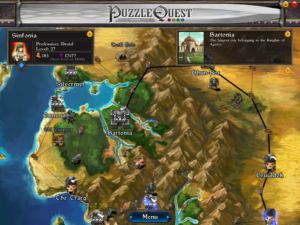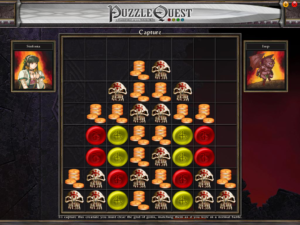IFComp 2008: Search for the Ultimate Weapon
One last game and I’m done for the year. This one is loosely inspired by the legend of Wu Mei, 17th century kung fu master. Spoilers follow the break.
Read more »
One last game and I’m done for the year. This one is loosely inspired by the legend of Wu Mei, 17th century kung fu master. Spoilers follow the break.
Read more »
 Outside of combat, Puzzle Quest plays more or less like a conventional RPG, but one played on a scale I more associate with strategy games such as Heroes of Might and Magic or Master of Orion. All travel is conducted on an overland map, and constrained to delineated paths between cities and other important sites. Anything within a city is represented as a bunch of menus. You can acquire companions over the course of the story, but they’re not full characters with their own stats like the PC. Instead, they provide situational combat help, such as automatically doing 10 points of damage at the beginning of battle when fighting undead, or increasing your Battle rating by 10 when fighting Good characters 1No, you don’t have the option of turning evil, or at least not in the parts I’ve seen. But there are some knights who you have to defeat in friendly matches to prove your worthiness. — in other words, the sort of bonus you’d get from a Leader or Hero in a strategy game. There’s even the option of conquering the cities you come across and collecting tribute from them. Tribute is generated every game month, and to collect it, you have to visit the cities personally, just like certain strategy-game resource generators. All in all, the frame game might be better described, not as RPG, but as strategy game with just one hero stack. But then, strategy games of this sort share a lot of mechanics with RPGs — they have a common ancestry in miniature wargaming, and the seminal Heroes of Might and Magic series in particular was based on the Might and Magic RPG series.
Outside of combat, Puzzle Quest plays more or less like a conventional RPG, but one played on a scale I more associate with strategy games such as Heroes of Might and Magic or Master of Orion. All travel is conducted on an overland map, and constrained to delineated paths between cities and other important sites. Anything within a city is represented as a bunch of menus. You can acquire companions over the course of the story, but they’re not full characters with their own stats like the PC. Instead, they provide situational combat help, such as automatically doing 10 points of damage at the beginning of battle when fighting undead, or increasing your Battle rating by 10 when fighting Good characters 1No, you don’t have the option of turning evil, or at least not in the parts I’ve seen. But there are some knights who you have to defeat in friendly matches to prove your worthiness. — in other words, the sort of bonus you’d get from a Leader or Hero in a strategy game. There’s even the option of conquering the cities you come across and collecting tribute from them. Tribute is generated every game month, and to collect it, you have to visit the cities personally, just like certain strategy-game resource generators. All in all, the frame game might be better described, not as RPG, but as strategy game with just one hero stack. But then, strategy games of this sort share a lot of mechanics with RPGs — they have a common ancestry in miniature wargaming, and the seminal Heroes of Might and Magic series in particular was based on the Might and Magic RPG series.
I mentioned conquering cities. This is done through the same tile-matching combat system as regular encounters, except that cities as opponents have a different special powers and different equipment slots: instead of one Helmet and one Armor and one Weapon, cities get one Tower and one Gate and so forth. Unfortunately, this game doesn’t support scavenging equipment from fallen foes. Otherwise, I would definitely try wearing an iron gate to my next encounter. You might think that conquering a city would be a big deal for the NPCs living there, but, in an extreme example of game/story orthogonality, no one seems to notice. At one point, I acquired a party member who gives a bonus during sieges, and he merrily helped me subjugate his home. At another point, I was on a diplomatic mission to a neighboring kingdom, trying to get their assistance against the undead hordes. On your first attempt at delivering your message, you’re turned away at the gate by a guard, even if you just laid siege to the place and conquered it.
Now, to back up a step, you might be wondering where equipment comes from if there’s no scavenging. Well, there are quest rewards, and there are stores in the cities, and there’s crafting. Crafting is accomplished through tile-matching. But! It is different this time. There’s no opponent, you can’t use spells, and your goal is to delete a certain number of special “hammer and anvil” tiles (the required number depending on the power of the item you’re crafting) before running out of legal moves. There are a few other variants like this for other special actions, like researching new spells (delete a quota of each color, and also of special “Book” tiles that only appear when you delete a row of 4 or more) or training mounts (defeat the mount with a time limit on each move).  My favorite such minigame is the one used for capturing creatures (so you can learn spells from them or use them as mounts), which is, to my mind, the only part of the game that really qualifies as a puzzle. You’re given an arrangement of tiles, but unlike all other occasions, it’s not random, it’s not full, and it doesn’t fill up. Your goal is to delete everything, which can be trickier than it sounds.
My favorite such minigame is the one used for capturing creatures (so you can learn spells from them or use them as mounts), which is, to my mind, the only part of the game that really qualifies as a puzzle. You’re given an arrangement of tiles, but unlike all other occasions, it’s not random, it’s not full, and it doesn’t fill up. Your goal is to delete everything, which can be trickier than it sounds.
| ↑1 | No, you don’t have the option of turning evil, or at least not in the parts I’ve seen. But there are some knights who you have to defeat in friendly matches to prove your worthiness. |
|---|
Final Fantasy is something of a genre unto itself. Moreso, in my opinion, than most game franchises. There’s a significant number of people who play the Final Fantasy games and no other CRPGs. It has its own convetions and vocabulary, things that fans of the series understand from earlier games, making it easier for those in the know but harder for outsiders to get in — something that I’d argue is a big part of genre in any medium.
Often, genre in games is reinforced by things that don’t make sense, but which the player doesn’t question.
Usually it’s a matter of gameplay considerations trumping common sense, as is right and proper. In most first-person shooters, you can take multiple bullets to the chest without so much as slowing down, because the alternative would be a less enjoyable game. You can make in-game excuses for it, declare that the player is wearing power armor or something, but you don’t really need to, because most of the players understand the conventions of the genre.
Or consider healing items, potions and medikits and so forth that instantly remove damage when used. One of the most ridiculous things I’ve ever seen in a noninteractive cutscene was a moment in the final boss battle of Prince of Persia 3D — not The Sands of Time, but the largely-forgotten one from several years before. In it, the baddie you’re fighting (some kind of anthropomorphic tiger), badly beaten, takes a moment to pull out a vial of orange fluid, uncork it, and gulp it down, restoring him enough to begin the next stage of the fight. It’s not at all unusual in games for players to do this sort of thing, but the presentation here makes it seem like part of the story rather than part of the game, and that draws attention to the absurdity of the idea.
Final Fantasy has healing potions, which can be used in combat. It also has a number of status effects which can be cured with specific items: “Antidote” for poisoned characters, “Soft” for petrified ones, “Cornucopia” for those artificially aged by magical aging effects — not all of the effects are obvious, but since they’re mostly the same from game to game, you learn them. Or, if you have enough mana, you can cure any status effect with the spell Esuna, a nonsense word that doesn’t seem to mean anything in Japanese either, but which players of the series will recognize immediately.
But if you’re really low on mana, you should stay at an inn, which heals the entire party, recovers mana, and removes status ailments all at once. If you’re not near an inn, there are tents and cottages, which are like small, portable inns. (Based on the graphics, “cottage” is probably a mistranslation. It looks like a larger tent.) The animation that results from using a tent or cottage makes it clear that you’re staying in it overnight, although it only takes a few seconds of real time. Unlike potions, you can’t use them during combat — in fact, you can only use it in places where you can save the game, which is to say, anyplace outdoors plus save points in dungeons. But like potions, tents and cottages are single-use items. That’s their first violation of common sense. It reminds me a little of the keys in early Ultimas, which were more like single-use lockpicks.
The second violation is something that I don’t think really came up in FF1, but which I’ve just had a fairly big dose of in FF5. There are portions of this game where it tries to create a sense of urgency in the story that isn’t actually present in gameplay. At one point, for example, you infiltrate the tower that’s projecting the force field around X-Death’s castle. While you climb to the tower’s peak, Zeza the Dawn Warrior goes to the basement to where the bulk of the machinery is housed and waits for you, first reminding you to hurry, because you don’t have much time before X-Death’s forces overwhelm you. You battle your way up through the tower, and just before the top, hey! A save point! Let’s pitch camp.
My point isn’t that this is unrealistic. My point is that it actually took me a day or so to remember this. The mission is part of the plot, and the tent is part of the game, and seldom the twain shall meet.